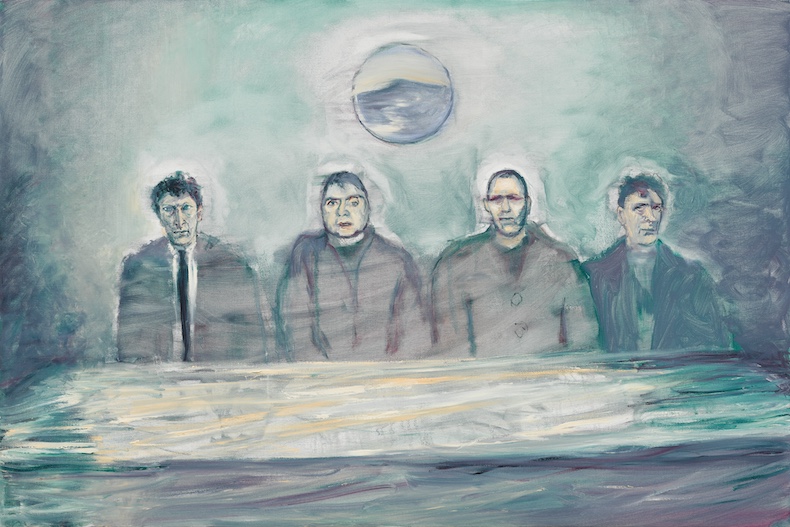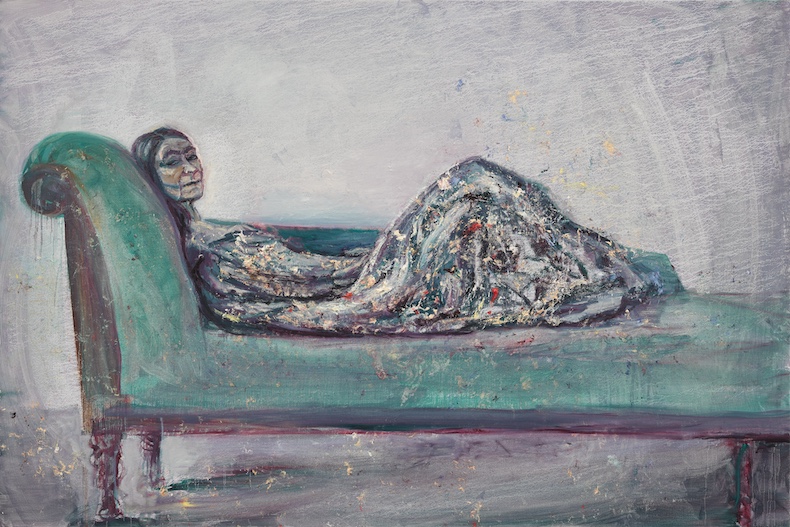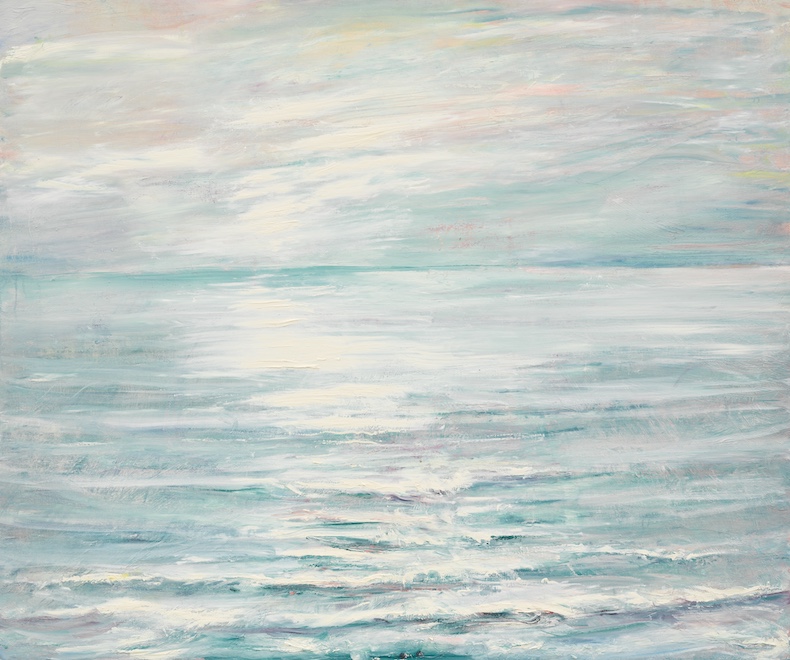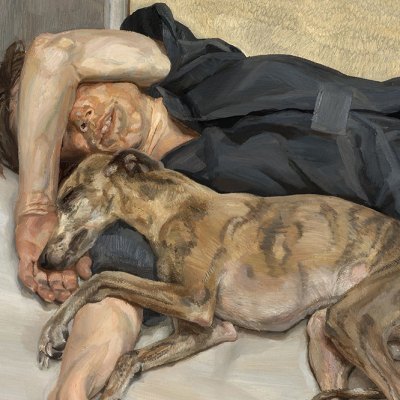Two large portraits hang facing each other from opposite walls in Celia Paul’s new exhibition at Victoria Miro in London. On the right is Colony of Ghosts, the picture from which the show takes its title. Based on John Deakin’s famous photograph from 1963 of School of London painters having lunch at Wheeler’s restaurant – a picture taken long before she knew them, and before her relationship with Lucian Freud began – Paul’s painting takes the figures of Freud, Francis Bacon, Frank Auerbach and Michael Andrews and reimagines them against a watery, abstracted background. The table before them is half infinity pool, half mortician’s slab. Behind them is something that looks like a porthole in a ship’s cabin or perhaps a mirror-ball, but this is a sombre lunch party. They all look a bit worried. On the left-hand wall, facing them, is a picture of Celia Paul in the present day, reclining on a chaise longue, with everything but her head contained in a full-length smock that’s covered with paint. (She has done a lovely job at painting the paint.) Her gaze is turned towards the viewer, and therefore, in this hanging, towards her powerful male predecessors.
Colony of Ghosts (2023), Celia Paul. Courtesy the artist/Victoria Miro; © the artist

As Karl Ove Knausgaard writes in the new monograph dedicated to Paul, published by MACK, there is inevitably ‘an element of competition, an element of combat, in the work, if only as negation’. The relationship between these two paintings, whether we read it as a confrontational reckoning or a gaze of sad acceptance from present to past, is so carefully and deliberately staged that it’s in danger of being a little overbearing, a little too in control of its meaning. This is an occupational hazard for a painter who writes as lucidly about her own work as Paul has done in her memoir, Self-Portrait (2019) and in a new essay, Painting Myself, included in the new monograph. Writing about the reclining self-portrait, she says that ‘though my head is turned towards the viewer, my gaze is inward’, and that the hanging of the two paintings opposite each other means that ‘the men can observe me, and I can observe them’. Fruitfully, it’s an account that still leaves the meaning of the interaction open to interpretation. Maybe it’s Paul decisively staking her claim to emerge from the shadow of the male art-monsters; or maybe not. ‘The last thing we learn in life is our effect upon other people,’ George Eliot wrote in Middlemarch.
The mythology around Paul’s work has had a thorough going-over in recent years: her relationship with Freud, which began when she was an 18-year-old student and he a 55-year-old professor at the Slade (bad Lucian!); the pictures he painted that used her as a model; the flat and studio in Bloomsbury that he bought for her (good Lucian?), where she continues to live a monkish, paint-spattered life, with barely any furniture. As a story, it seems to be from another time – a second-wave feminist fable playing out long after the other participants have all died.
Reclining Painter (2023), Celia Paul. Courtesy the artist/Victoria Miro; © the artist

Writing in 2019, Rachel Cusk – it is interesting that autofictioneers such as Cusk and Knausgaard are so drawn to Paul’s work – found herself unable to ‘believe in Celia Paul’s life’, and barely able to contain her impatience with it. (The piece weirdly ends by speculating on why Paul hasn’t sorted out an extension of the lease on her flat.) Cusk turns her into a novelistic character, ‘a kind of modern-day Jane Eyre’: ‘her intensity and sense of election were matched only by her vulnerability’. But of course, people aren’t characters. Part of the struggle for Paul in these new self-portraits is to avoid turning herself too much into a character. The insistent posing of herself and her sisters in plain white smocks, like members of a religious cult, probably doesn’t help. But it’s in the faces where the real action happens, where the soul trembles out through the layers of story and biography.
Paul’s portraits are rightly the main focus of the exhibition, but it also includes seascapes, a waterfall, a view outward from a watery cave and a large-scale picture of a weeping birch. They unavoidably come to echo or comment upon the human subjects among which they hang. The weeping birch companionably speaks to the two pictures featuring Paul herself as weeping muse. The watery paintings become a metaphor for the attempt in the portraits to still the process of time and change. Whether we look outward towards shimmering waves stacked on top of each other, as in The Sea, The Sea (2024), or look across the water to a headland, or watch it crashing downwards into a pool as in Force (2024), we are invited to ponder – gently – time and memory. The distortions that play across the distance between past and present shimmer through in the different ways light falls on moving water. These seascapes aren’t quite as distinctive as Paul’s portraits – one finds oneself vaguely waiting for a human figure to emerge between the waves – but layered into her body of work as they are in this show, they add sombre depth to her contemplative art.
The Sea, The Sea (2024), Celia Paul. Courtesy the artist/Victoria Miro; © the artist

‘Celia Paul: Colony of Ghosts’ is at Victoria Miro, London, until 17 April 2025. An accompanying monograph, Celia Paul: Works 1975–2025 is published by MACK.



